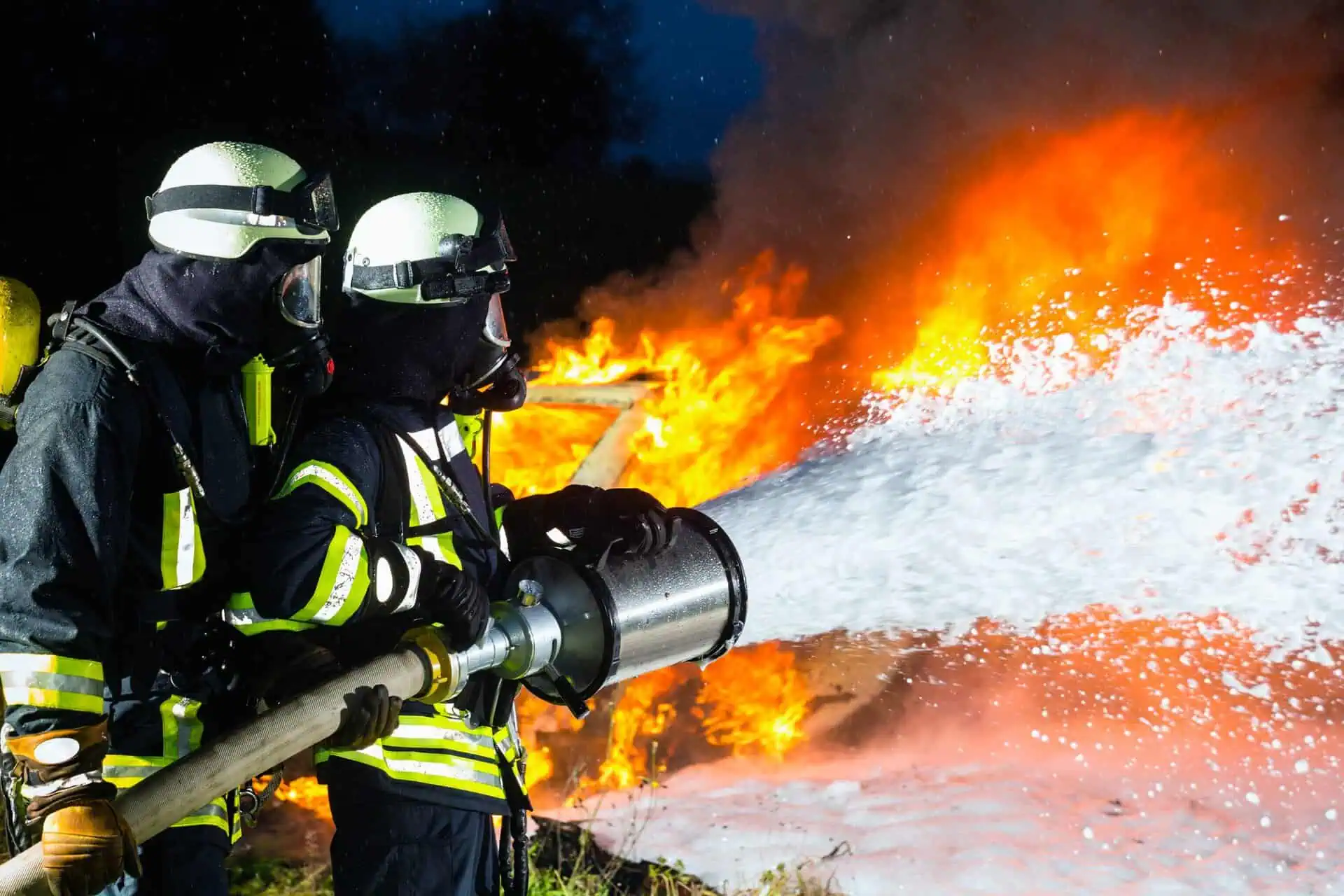FAQ: Is There An AFFF Class Action Lawsuit?
- Last Updated: July 14th, 2025

Attorney Jessica Paluch-Hoerman, founder of TruLaw, has over 28 years of experience as a personal injury and mass tort attorney, and previously worked as an international tax attorney at Deloitte. Jessie collaborates with attorneys nationwide — enabling her to share reliable, up-to-date legal information with our readers.
Legally Reviewed
This article has been written and reviewed for legal accuracy and clarity by the team of writers and legal experts at TruLaw and is as accurate as possible. This content should not be taken as legal advice from an attorney. If you would like to learn more about our owner and experienced injury lawyer, Jessie Paluch, you can do so here.
Fact-Checked
TruLaw does everything possible to make sure the information in this article is up to date and accurate. If you need specific legal advice about your case, contact us by using the chat on the bottom of this page. This article should not be taken as advice from an attorney.
Key takeaways:
- An experienced attorney familiar with multidistrict litigation (MDL) involving fire and firefighting foam (AFFF) cases understands how defense strategies play out and can effectively counter them.
- In AFFF (Aqueous Film Forming Foam) cases, settlement payouts for firefighters affected by the harmful effects of PFAS in this firefighting foam are crucial.
- If you or a loved one has been affected by exposure to Aqueous Film Forming Foam (AFFF) used in firefighting, there are legal avenues available to seek justice and financial compensation.
Is There an AFFF Class Action Lawsuit?
Question: Is There an AFFF Class Action Lawsuit?
Answer: In short, No.
The AFFF lawsuits have been consolidated into a multidistrict litigation (MDL), with over 5,000 AFFF firefighting foam cases currently pending.
On this page, we’ll discuss this question in further depth, potential AFFF lawsuit settlement amounts, who qualifies to file an AFFF lawsuit, and much more.
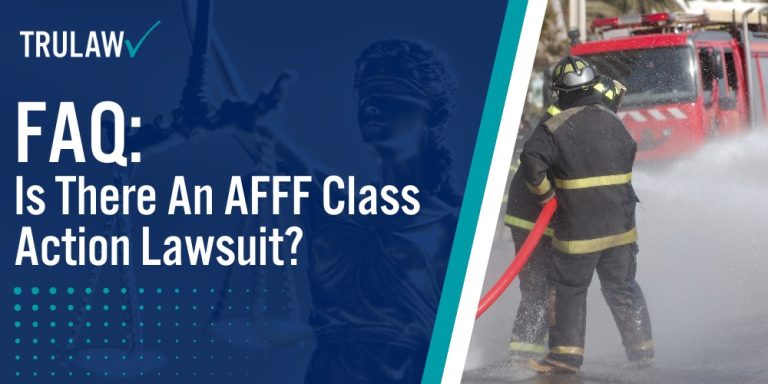
AFFF Lawsuits Consolidated into Multidistrict Litigation (MDL)
Thousands of lawsuits have been filed against the manufacturers of aqueous film-forming foam (AFFF) due to concerns over the harmful effects of PFAS (per- and polyfluoroalkyl substances) found in certain firefighting foam products.
These chemicals, often referred to as “forever chemicals,” persist in the environment and the human body, leading to serious health concerns, including cancer.
With the growing number of claims filed against these manufacturers, the courts have consolidated the cases into a multidistrict litigation (MDL) to efficiently handle the legal process involved in AFFF lawsuits.
If you or a loved one were exposed to AFFF firefighting foam and later developed cancer or other serious health conditions, you may qualify to pursue legal action.
You can use the chatbot on this page to receive a free instant case evaluation and find out if you may be eligible to file an AFFF lawsuit.
The experienced firefighting foam lawyers at TruLaw and our partner law firms understand the impact toxic firefighting foam can have on health, and we are committed to supporting clients through the legal process.
If you believe you’ve been affected by AFFF exposure, reach out today to learn how TruLaw can assist you by using the chat on this page for an instant case evaluation to quickly determine if you qualify to file an AFFF lawsuit.
Table of Contents
AFFF Firefighting Foam Lawsuits Merged into the AFFF Firefighting Foam MDL
As awareness of the potential health risks associated with AFFF and PFAS exposure has grown, numerous lawsuits have been filed across the country against AFFF manufacturers.
Due to the rising number of claims, these lawsuits were consolidated into a multidistrict litigation (MDL), known as the AFFF MDL.
The AFFF Firefighting Foam MDL is currently centralized in the US District Court for the District of South Carolina.
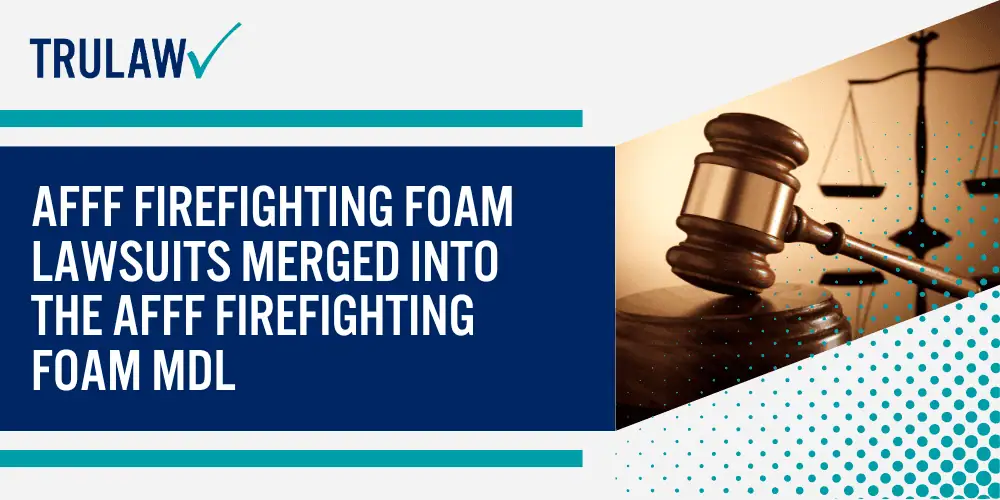
MDLs offer an efficient way to manage cases involving similar allegations by streamlining the legal process, ensuring consistent rulings, and working toward a more efficient resolution for all involved parties.
In this case, the AFFF MDL addresses the alleged adverse health effects related to PFAS exposure from firefighting foam.
Is There a Class Action Lawsuit for AFFF Firefighting Foam?
No, there is not a class action lawsuit specifically for individuals suffering health issues due to AFFF exposure.
Instead, these individual cases have been consolidated into multidistrict litigation (MDL), which is different from a class action lawsuit.
A common misconception is that the AFFF MDL functions like a class action, but they are two distinct types of legal actions.
While class action lawsuits are typically brought forward by a group with a common claim, the AFFF MDL focuses on managing multiple individual cases related to health issues from firefighting foam exposure.
Firefighting foam class action lawsuits have been filed in the past by municipalities and other public entities against AFFF manufacturers, primarily for the contamination of public water sources with PFAS.
One such example is the City of Stuart v. 3M Co., where the city alleged that 3M polluted its water supply with toxic PFAS and PFOA chemicals.
This case was resolved when 3M settled for a confidential amount, putting the matter to rest.
What Is a Multidistrict Litigation (MDL)?
The multidistrict litigation (MDL) process involves combining similar cases from multiple federal courts into one court to handle pretrial activities collectively.
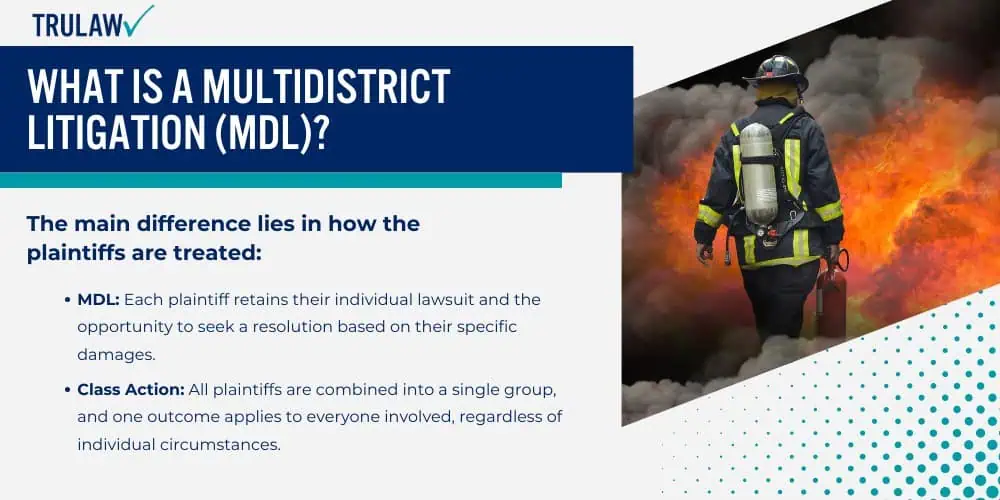
This process allows for a more streamlined approach to handling multiple claims, helping to reduce repetitive discovery and avoid inconsistent rulings.
It’s important to understand that MDLs are distinct from class action lawsuits.
In an MDL, the individual cases remain separate and are not merged into one collective suit.
Instead, the goal is to manage pretrial matters efficiently while ensuring each case retains its unique characteristics.
MDLs are common in product liability cases, where numerous lawsuits with similar claims are filed against related companies.
Differences Between MDL and Class Action Lawsuits
MDLs and class action lawsuits are often confused, but they operate quite differently.
Some advertisements may incorrectly refer to the AFFF lawsuits as “class action MDLs” or “class action lawsuits,” but this is not accurate.
In a class action, a group of individuals with similar claims sues the defendant(s) as a collective unit.
A single outcome applies to all members, with plaintiffs being treated as one group.
Conversely, in an MDL, the cases are consolidated for pretrial matters, but each plaintiff maintains the right to pursue their case individually.
The main difference lies in how the plaintiffs are treated:
- MDL: Each plaintiff retains their individual lawsuit and the opportunity to seek a resolution based on their specific damages.
- Class Action: All plaintiffs are combined into a single group, and one outcome applies to everyone involved, regardless of individual circumstances.
Another distinction is how settlements are distributed.
- In MDLs, compensation is awarded based on the facts and damages of each individual case.
- In class actions, a lump-sum settlement is divided evenly among all plaintiffs, regardless of the unique impacts on each person.
How Does the MDL Process Work?
The MDL process simplifies litigation by consolidating AFFF lawsuits with common factual or legal issues.
Below are the core components of how an MDL functions.
Filing of Numerous Related Lawsuits
An MDL arises when multiple lawsuits with similar claims are filed, often involving similar injuries or harm caused by a specific product.
For AFFF lawsuits, the focus is on the health effects of PFAS exposure from firefighting foam, which has led to numerous cases being filed across the country.
Once a large number of related cases have been filed, the attorneys may request the Judicial Panel on Multidistrict Litigation (JPML) to centralize the cases for pretrial management.
Consolidating Similar Cases in an MDL
If the JPML grants the motion to centralize, the cases are transferred to a designated federal court for pretrial proceedings.
A single judge oversees the entire MDL to ensure consistency and efficiency in handling the litigation.
One of the key factors considered in choosing the court is the convenience of the plaintiffs.
Creating Order Within the MDL Parties
Once the cases are consolidated, a leadership structure is put in place, typically through the appointment of a steering committee.
This committee is responsible for organizing and coordinating the legal strategy for both plaintiffs and defendants.
While the steering committee oversees the broader aspects of the litigation, individual plaintiffs still retain their own legal representatives, ensuring that each case is handled according to its specific facts.
The Role of Bellwether Trials
To help assess the strength of the claims, a few representative cases are selected for trial.
These are known as bellwether trials.
The outcomes of these trials provide valuable insight into how future cases might proceed and can influence potential settlement negotiations.
Distribution of Mass MDL Settlements
If the bellwether trials result in favorable outcomes for the plaintiffs, it may prompt defendants to consider a settlement.
When a settlement is reached, it is distributed among the plaintiffs based on the specific details and damages of each individual case within the MDL.
This approach ensures that each plaintiff is compensated in line with their personal circumstances, rather than receiving an equal share as they would in a class action.
What Happens When You File an AFFF Firefighting Foam Lawsuit?
If you’ve been exposed to AFFF firefighting foam and developed cancer or other related health issues, you may be eligible to file an AFFF lawsuit.
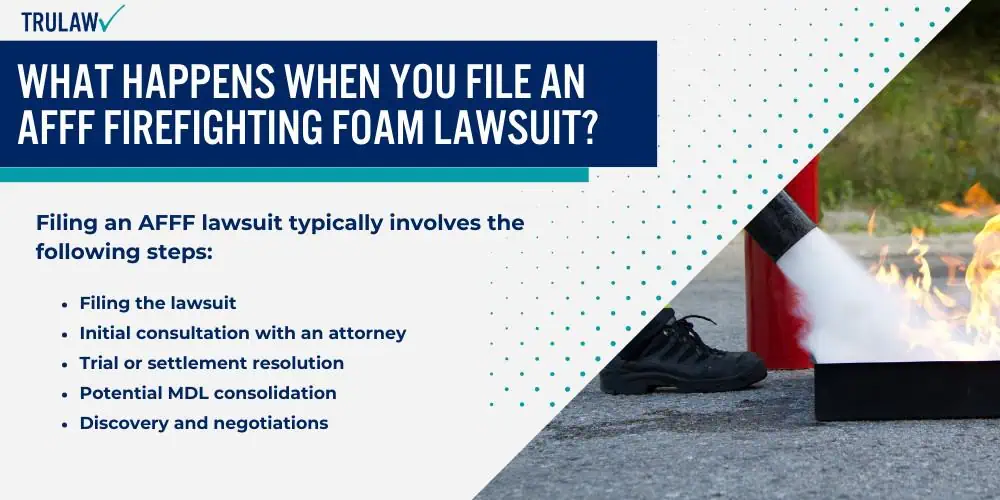
Filing an AFFF lawsuit typically involves the following steps:
- Filing the lawsuit: Once your case has been reviewed, the attorney will file a formal complaint on your behalf, detailing the circumstances of your exposure and the health impacts you’ve experienced.
- Initial consultation with an attorney: The first step is to consult with an attorney experienced in AFFF-related cases. They will review your situation, assess your eligibility, and guide you through the legal process.
- Trial or settlement resolution: Depending on the outcome of negotiations, your case may proceed to trial, or a settlement may be reached to provide financial compensation for your damages.
- Potential MDL consolidation: If your case shares similarities with others, it may be consolidated into the AFFF Multidistrict Litigation (MDL) for pretrial proceedings to streamline the legal process.
- Discovery and negotiations: During discovery, both sides exchange relevant information, such as medical records and expert testimony. Settlement negotiations may take place at any point, either before or after early trial phases, often referred to as bellwether trials.
Overview of the AFFF Lawsuit
The rising number of AFFF firefighting foam lawsuits is tied to the serious health effects linked to its use.
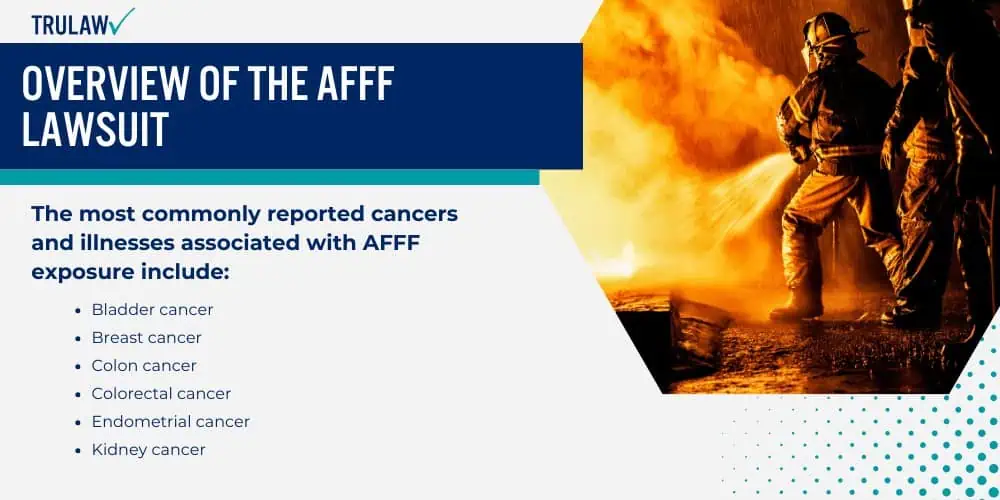
AFFF contains PFAS chemicals, which have been found to contribute to several health conditions, including cancer, reproductive issues, and immune system disorders.
If you believe your health has been affected by exposure to AFFF or PFAS, gathering medical records and documentation is essential.
This evidence helps establish a clear connection between your health issues and exposure to these harmful chemicals.
It’s important to be aware that each state has its own time limits for filing lawsuits, known as statutes of limitations.
To file your claim on time, consult an attorney as soon as possible.
What Illnesses Are Linked to AFFF and PFAS Exposure?
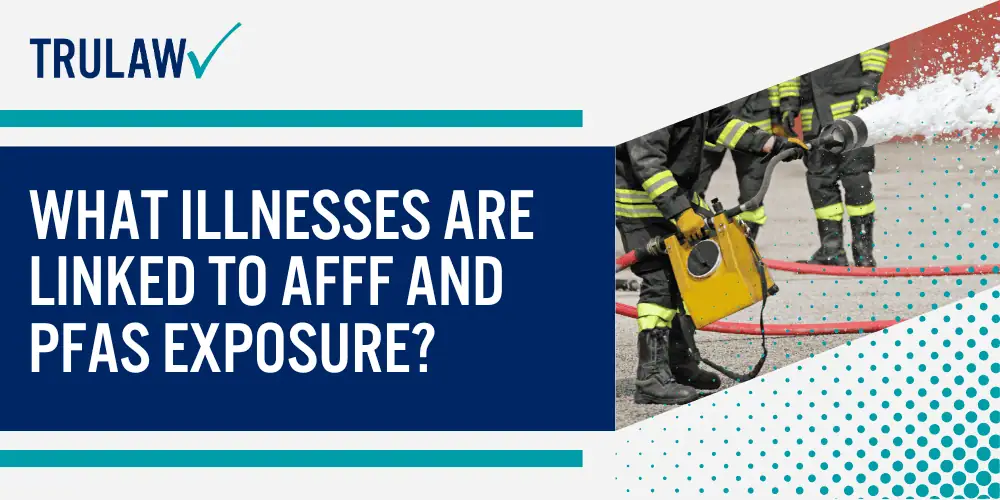
Exposure to AFFF and PFAS chemicals has been linked to numerous health conditions.
The most commonly reported cancers and illnesses associated with AFFF exposure include:
- Bladder cancer
- Breast cancer
- Colon cancer
- Colorectal cancer
- Endometrial cancer
- Kidney cancer
- Leukemia
- Liver cancer
- Lymphoma
- Mesothelioma
- Multiple Myeloma
- Non-Hodgkin Lymphoma
- Ovarian cancer
- Pancreatic cancer
- Prostate cancer
- Rectal cancer
- Testicular cancer
- Thyroid cancer
- Thyroid disease
- Ulcerative Colitis
- Birth defects and other reproductive issues
- Developmental problems
- Heart disease
- Hormonal imbalances
- Immune system disorders
- Liver damage
- Neuroendocrine tumors
- Reproductive issues
- Skin and eye irritation
- Other health complications
If you have experienced any of these conditions following AFFF exposure, it’s important to seek medical care and consult with an attorney to explore your legal options.
What Damages Can You Recover in an AFFF Lawsuit?
The damages you may be entitled to in an AFFF firefighting foam lawsuit depend on the specific circumstances of your case.
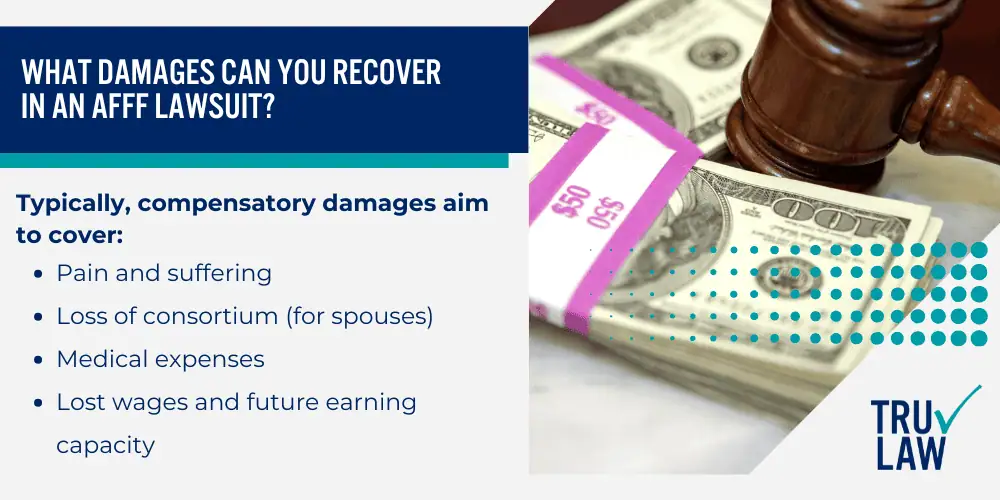
Typically, compensatory damages aim to cover:
- Pain and suffering: Compensation for the emotional and physical distress caused by your condition.
- Loss of consortium (for spouses): If you lost a spouse due to illness linked to AFFF exposure, compensation may be available for this loss.
- Medical expenses: Including current and future treatment related to your diagnosis.
- Lost wages and future earning capacity: If your illness impacts your ability to work, compensation may cover the loss of income.
An experienced legal team can help assess your situation and work to pursue compensation based on your unique circumstances.
How Can Experienced Firefighting Foam Attorneys Assist You?
If you’ve been affected by AFFF or PFAS contamination, knowledgeable legal support can be helpful.
The experienced firefighting foam lawyers at TruLaw and our partner law firms understand AFFF lawsuits and can guide you through the legal process, ensuring your rights are protected.
We are experienced in handling multidistrict litigations (MDL) and pursuing compensation for damages related to AFFF exposure.
TruLaw: Your AFFF Firefighting Foam Law Firm
Lawsuits are being filed against AFFF manufacturers for allegedly putting public health at risk due to the harmful chemicals in firefighting foam.
Individuals who were exposed to AFFF during military service or through their work have developed cancer and other serious health issues, waiting far too long for justice.
If you or a loved one were exposed to AFFF firefighting foam and later developed cancer or other related health problems, you may qualify to file an AFFF lawsuit and seek financial compensation.
Contact us today for a free case consultation by using the chat on this page for an instant case evaluation and quickly find out if you qualify for the AFFF lawsuit.
The AFFF firefighting foam lawyers at TruLaw and our partner law firms are ready to hear your story, assess your AFFF claims, and help you determine the next steps in pursuing compensation.
It’s important to note that TruLaw is only accepting clients with AFFF personal injury lawsuits — we are not accepting clients for the AFFF municipal water contamination lawsuits.
AFFF Lawsuit Frequently Asked Questions
-
This is a question we hear frequently.
The answer isn’t straightforward — it’s both yes and no.
To better understand the situation, keep the following key points in mind:
- There is no AFFF class action lawsuit for cancer or other serious health issues caused by exposure.
- Class action lawsuits have been filed regarding PFAS contamination from AFFF use, but they do not include individuals exposed at work, such as firefighters.
- The lawsuits for people suffering from cancer and other injuries related to AFFF exposure are being handled through multidistrict litigation (MDL).
No AFFF class action lawsuit for cancer & other serious health issues
It’s easy to assume there is a class action lawsuit for health issues caused by AFFF exposure, but that is not the case.
Instead, for those dealing with cancer or other health problems due to AFFF, the legal action falls under multidistrict litigation (MDL), not a class action lawsuit (more details below).
Individuals exposed to AFFF at work are not included in PFAS contamination class action lawsuits
While class action lawsuits have been filed related to PFAS contamination from AFFF use, they do not cover individuals who were exposed to AFFF in their workplace.
Workers exposed to AFFF on the job are not included in these class actions.
However, they can seek compensation through the multidistrict litigation discussed below.
Multidistrict litigation (MDL) for individuals suffering from cancer & other injuries
Those who have suffered cancer and other injuries from AFFF exposure are part of multidistrict litigation, not a class action lawsuit.
MDL is a legal process that consolidates similar cases into one court, under one judge, for pretrial proceedings, making the legal process more efficient.
In conclusion, while there are class action lawsuits related to AFFF, they do not cover individuals affected by cancer or other serious health conditions due to exposure.
The legal action for these individuals is an MDL, not a class action lawsuit.
-
Many workers across different industries have experienced occupational exposure to firefighting foam.
AFFF foam has been widely used by the US military, municipal fire departments, airports, chemical plants, and other industries dealing with flammable liquid fires caused by class B materials.
Workers at risk of AFFF exposure include:
- Chemical plant workers
- Military firefighters
- Other military personnel handling firefighting operations
- Flight deck workers
- Airport personnel
- Municipal firefighters
- Workers involved in the transportation or disposal of AFFF
- Employees in other related industries
-
Numerous companies have been named in lawsuits related to toxic exposure and injuries caused by firefighting foam.
The manufacturers named in the AFFF lawsuits include:
- Chemours
- Chemguard Inc.
- 3M
- Tyco Fire Products
- DuPont
- ChemDesign Inc.
- Over a dozen other companies
These companies are being held accountable for the harmful effects of AFFF and its links to serious health conditions.
-
As of now, no settlements have been reached in the AFFF litigation.
However, AFFF lawyers estimate that potential settlement amounts may range from $20,000 to $600,000 (or more), depending on the strength of the case and other specific factors.
These figures are not guaranteed but are projections based on settlements in similar mass tort cases involving cancer diagnoses.
-
Research has shown that exposure to firefighting foam containing PFAS chemicals is linked to several serious health issues, including various cancers.
Cancers associated with AFFF exposure include:
- Bladder cancer
- Breast cancer
- Colorectal cancer
- Endometrial cancer
- Kidney cancer
- Leukemia
- Liver cancer
- Lymphoma
- Mesothelioma
- Multiple Myeloma
- Non-Hodgkin Lymphoma
- Ovarian cancer
- Pancreatic cancer
- Prostate cancer
- Testicular cancer
- Thyroid cancer
Other health problems linked to AFFF exposure include:
- Changes in liver enzyme function
- Slight decreases in birth weight for infants
- Reduced vaccine response in children
- Elevated cholesterol levels
- Higher risk of high blood pressure or pre-eclampsia in pregnant women
These health risks underscore the severity of AFFF exposure, particularly for those who have had long-term contact with the foam.

Managing Attorney & Owner
With over 25 years of legal experience, Jessica Paluch-Hoerman is an Illinois lawyer, a CPA, and a mother of three. She spent the first decade of her career working as an international tax attorney at Deloitte.
In 2009, Jessie co-founded her own law firm with her husband – which has scaled to over 30 employees since its conception.
In 2016, Jessie founded TruLaw, which allows her to collaborate with attorneys and legal experts across the United States on a daily basis. This hypervaluable network of experts is what enables her to share the most reliable, accurate, and up-to-date legal information with our readers!
Additional AFFF Lawsuit resources on our website:
Here, at TruLaw, we’re committed to helping victims get the justice they deserve.
Alongside our partner law firms, we have successfully collected over $3 Billion in verdicts and settlements on behalf of injured individuals.
Would you like our help?
At TruLaw, we fiercely combat corporations that endanger individuals’ well-being. If you’ve suffered injuries and believe these well-funded entities should be held accountable, we’re here for you.
With TruLaw, you gain access to successful and seasoned lawyers who maximize your chances of success. Our lawyers invest in you—they do not receive a dime until your lawsuit reaches a successful resolution!
AFFF Lawsuit claims are being filed against manufacturers of aqueous film-forming foam (AFFF), commonly used in firefighting.
Claims allege that companies such as 3M, DuPont, and Tyco Fire Products failed to adequately warn users about the potential dangers of AFFF exposure — including increased risks of various cancers and diseases.
Depo Provera Lawsuit claims are being filed by individuals who allege they developed meningioma (a type of brain tumor) after receiving Depo-Provera birth control injections.
A 2024 study found that women using Depo-Provera for at least 1 year are five times more likely to develop meningioma brain tumors compared to those not using the drug.
Suboxone Tooth Decay Lawsuit claims are being filed against Indivior, the manufacturer of Suboxone, a medication used to treat opioid addiction.
Claims allege that Indivior failed to adequately warn users about the potential dangers of severe tooth decay and dental injuries associated with Suboxone’s sublingual film version.
Social Media Harm Lawsuits are being filed against social media companies for allegedly causing mental health issues in children and teens.
Claims allege that companies like Meta, Google, ByteDance, and Snap designed addictive platforms that led to anxiety, depression, and other mental health issues without adequately warning users or parents.
Transvaginal Mesh Lawsuits are being filed against manufacturers of transvaginal mesh products used to treat pelvic organ prolapse (POP) and stress urinary incontinence (SUI).
Claims allege that companies like Ethicon, C.R. Bard, and Boston Scientific failed to adequately warn about potential dangers — including erosion, pain, and infection.
Bair Hugger Warming Blanket Lawsuits involve claims against 3M — alleging their surgical warming blankets caused severe infections and complications (particularly in hip and knee replacement surgeries).
Plaintiffs claim 3M failed to warn about potential risks — despite knowing about increased risk of deep joint infections since 2011.
Baby Formula NEC Lawsuit claims are being filed against manufacturers of cow’s milk-based baby formula products.
Claims allege that companies like Abbott Laboratories (Similac) and Mead Johnson & Company (Enfamil) failed to warn about the increased risk of necrotizing enterocolitis (NEC) in premature infants.
Here, at TruLaw, we’re committed to helping victims get the justice they deserve.
Alongside our partner law firms, we have successfully collected over $3 Billion in verdicts and settlements on behalf of injured individuals.
Would you like our help?
